Tags
Blue Lettuce, coastal wildflowers, Duke of Argyll's Tea Plant, flowering in August, late summer wildflowers, Llandudno, North Wales Wildlife Trust, seashore, West Shore
August 19th
On Sunday, the North Wales Wildlife Trust held their annual August “Go Wild” event at Llandudno’s West Shore. From the outset a powerful wind brought a truly Wild element to the proceedings, but the sun shone, it wasn’t cold and better still, it didn’t rain! And we’re a hardy and resourceful lot here in North Wales, so marquees, stalls and games were battened down and sheltered behind a windbreak of cars, big NWWT vans & the minibus all parked bumper to bumper, Wild West Wagon style. All well worth the effort as it turned out to be a really successful and enjoyable day, well-attended by a good number of interested and enthusiastic people of all ages.
Having volunteered to guide a Wildlife Wander on the day I’d done an advance recce on Thursday afternoon of the route I had in mind to get an idea of what we might see and to take photographs that I wouldn’t have chance to do out with a group of people. It was windy then, but even more so on Sunday, so seeking some shelter from it, and in consideration of some young, tiny but very game wanderers we made a bit of a deviation from the original plan, but happily still managed to see most of the species of wildflowers I’d noted on Thursday, plus a couple I didn’t.
August 15th
Sunday’s wander would set out from our pitch next to the Children’s Playground on the Promenade, but at just past two o’clock today, although it was sunny, a strong wind was blowing and as it’s very open and exposed here I started further down, closer to where the dunes begin. A well-used path starts from Trinity Crescent, passes behind the buildings on the site of the Miniature Railway and travels in a fairly straight line to join the Coast Path through an open, grassy area.
On first impressions, this may appear to be an unkempt wasteland but a lot of wildlife loves such habitat and it’s always well worth closer inspection. This particular patch is home to a great variety of wildflowers, which then attracts insects and if you’re lucky, birds too.
 Some wildflowers are tall and so abundant that you can’t fail to notice them, like Common Mallow. It’s currently in full bloom and full of pretty pink-purple flowers hoping to catch the attention of any passing pollinators.
Some wildflowers are tall and so abundant that you can’t fail to notice them, like Common Mallow. It’s currently in full bloom and full of pretty pink-purple flowers hoping to catch the attention of any passing pollinators.
Between stands of Mallow there’s less showy Wild Carrot, largely finished flowering now and setting seed. This is one plant that is definitely in its favoured habitat- rough grassland, on chalky soil and by the sea. It’s a white umbellifer that’s more distinctive than most, as in the centre of the flowerhead is usually a single red-purple flower which is thought to mimic a fly that then attracts insects to assist pollination. After flowering the long umbels fold upwards and inwards to contain the seeds in a sort of cage.
I saw an insect on a flowerhead and tried to photograph it, but as you can see the wind was blowing it all over the place and I couldn’t focus on it properly – when I checked the photograph later I saw it was a Sawfly – Rhogogaster viridis.
There’s a good number of Ragwort plants, many of which were being visited by bees. Most of those I saw were Buff-tailed Bumblebees; big and strong enough to fly between plants on a windy day, although even they weren’t going far.
I checked a lot of plants here looking for the black and yellow caterpillars of the Cinnabar Moth-Tyria jacobeaea, but there were none that were obvious.
Another abundant flowering plant is Soapwort, which has been left undisturbed and has formed some impressively large patches. It’s in full bloom now and a mass of pretty sugar-pink flowers.

Soapwort-Saponaria officinalis
Bees seem to like these flowers too.
The green leaves and stems of Soapwort were once crushed and boiled in water to make a lathery liquid that was widely used to wash wool and woollen cloth. For that reason it was often grown in fields and gardens close to woollen mills, and the plants growing in the wild today are often found close to places where wool was once woven into cloth.
Across the grass at the far end, in front of the Blue Café and next to the entrance to the Miniature Railway is a big tangled bramble bush and my attention was attracted there as a cheerfully noisy flock of birds flew onto it. They were Starlings, most, or maybe all of which I think were juvenile birds, their plumage largely brown with black breast and underparts black with clear white spots.
They were clearly enjoying feasting on ripe blackberries.
The path leading to the sea is open and exposed to the elements, so plants need to be tough to succeed here. Mugwort is one that both survives and thrives here, it’s not an especially attractive plant to look at, but it’s well adapted to its environment and it also produces aromatic oils, a device to protect itself from being eaten by grazing animals. On Sunday, the general consensus of those that rubbed leaves and tested it was that’s it’s scent is not particularly pleasant, but then it is supposed to repel midges, which may be handy to know….
Golden yellow Ragwort and purple Greater Knapweed – the classic colours of late summer and early autumn.
 In contrast to the Mugwort, Greater Knapweed is tough and lovely to look at – its open ripe seedheads are as pretty as the flowers.
In contrast to the Mugwort, Greater Knapweed is tough and lovely to look at – its open ripe seedheads are as pretty as the flowers.
In the grass there was Cat’s-ear Hypochaeris glabra and what was possibly a small hawkbit – they’re tricky to separate at the best of times. Also small amounts of a white-flowered Common Storksbill, some Restharrow, White Clover, Pale Flax and the odd Dandelion or two were still to be found with flowers.
Where our path met the Coast Path was a lovely spreading patch of the yellow-flowered Ribbed Melilot.
Known as a plant of grassy places and waste ground, it seems to be perfectly happy growing in this sandy stony spot close to the sea.
A more common and familiar plant is the Sea Mayweed, a plant of sand and shingle, it can and does pop up in a variety places near to the sea if a seed finds a spot it likes.
At this end of the path there’s a mass of Sea Buckthorn. This is a thorny shrub with silvery stems and grey-green leaves. It’s flowers are tiny and green and appear before the leaves in the Spring, but now it is now laden with heavy crops of bright orange berries.
 From here the path, which is also a section of the Wales Coast Path, heads towards the dunes and Deganwy. The views ahead and across the sea to Anglesey and Puffin Island were surprisingly clear today, although there were rainclouds hanging over Snowdonia.
From here the path, which is also a section of the Wales Coast Path, heads towards the dunes and Deganwy. The views ahead and across the sea to Anglesey and Puffin Island were surprisingly clear today, although there were rainclouds hanging over Snowdonia.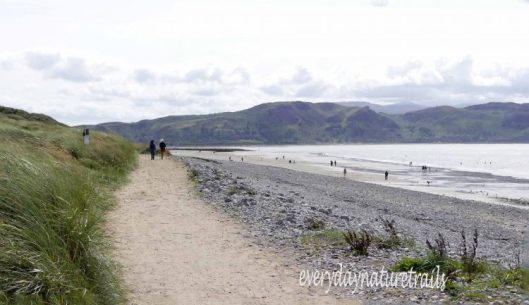
The wind had driven people trying to enjoy a day on the beach into the shelter of the dunes, some camped on the path, so I made a detour around them along the beach.
The strandline was strewn with piles of long tangled strands of seaweed: looking a bit like piles of brown spaghetti, this is Thongweed. If I’d been here spending a leisurely afternoon on the beach I would have had to collect some and plait it. In places it was mixed with other seaweeds that had also been wrenched away from their moorings on the submerged rocks.
Flitting around the drying seaweed there were a lot of little flies, perhaps unsurprisingly commonly known as Kelp or Seaweed Flies.
I photographed a pile of mixed seaweeds which includes Thong Weed, Egg Wrack (the one with big bubbles), Bladderwrack (with smaller bubbles) and some of the reddy-pink Polysiphonia algae that is a parasite of Bladderwrack.
Reaching the stone seabreak I rejoined the dunes, passing a big clump of Sea Rocket, the only one of our seashore plants to have lilac-coloured flowers.
I love this viewpoint and find it difficult to resist stopping here, and not just for the view: it’s furnished with a semi-circle of cut-stone slabs with lovely tactile polished tops, but it was too windy to hang about for long today. I did stop long enough to photograph the spikily beautiful large Sea Holly plant growing on the edge of the dune below.
Onwards through the dunes the path was slightly sheltered from the wind, although you can see how the bordering Marram grass was being pressed almost flat against the dune and cliff sides.
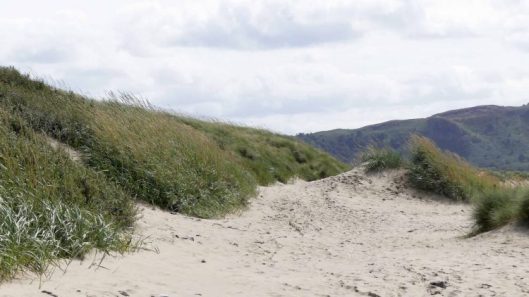 Marram grass has ripe, or ripening seedheads now held on tall stems that sway stiffly in the wind. The view is quite clear over to Anglesey.
Marram grass has ripe, or ripening seedheads now held on tall stems that sway stiffly in the wind. The view is quite clear over to Anglesey.
More Sea Holly and a very large clump of Sea Mayweed are flourishing in a sheltered spot.
 The dunes end and there opens up the amazing view of the iconic Vadre at Deganwy and the mountains on the far side of the Conwy Estuary.
The dunes end and there opens up the amazing view of the iconic Vadre at Deganwy and the mountains on the far side of the Conwy Estuary.
On the pathside Cat’s Ear is flowering and there is still quite a bit of Bird’s-foot Trefoil available to bees and butterflies, although all I saw today was a single Common Blue.
Whilst photographing the Cat’s Ear I noticed an insect scuttling about and now and then entering holes made in the sand. Long and black, with a purplish iridescence to its wings and a very narrow ‘waist’, so likely a sand wasp, but I don’t know the species.
More Sea Rocket, this time growing amongst the stones of the rip-rap. There were bumblebees nectaring on the windswept flowers.
On the cliff side of the path there’s more Bird’s-foot Trefoil and quite a lot of Restharrow still flowering.
On the cliffside itself, there’s an impressive spread of Rock Samphire. This is our most distinctive yellow-flowered umbellifer and the only one with fleshy leaves. It grows only by the sea.
And more Sea Mayweed, almost buried by sand.
 The path continues to curve around the bay towards Deganwy, but this is where I turned around to walk back.
The path continues to curve around the bay towards Deganwy, but this is where I turned around to walk back.
This point on the path is where I first saw the shrubby plant intriguingly named the Duke of Argyll’s Tea Plant. 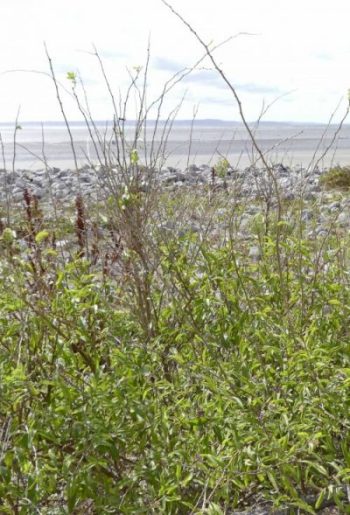 This member of the nightshade family with small purple flowers is not at all a showy plant, but it does have an interesting history.
This member of the nightshade family with small purple flowers is not at all a showy plant, but it does have an interesting history.
The story goes that Archibald Campbell, the 3rd Duke of Argyll received this plant, Lycium barbarum together with a tea plant, Camellia sinensis from China in the 1730s. Unfortunately their labels got mixed up, so it was grown under the wrong name in his Middlesex garden and, presumably when the mistake came to light, it subsequently became known as the Duke of Argyll’s Tea Tree or Tea Plant. (From A Dictionary of English Plant Names by Geoffrey Grigson, London 1973.)
The plant has been used in Britain since the 18th century for hedging, especially in coastal districts. Its red berries are attractive to a wide variety of British birds.
This view back along the path towards the Great Orme is wide and impressive and even better today as now the wind was behind me and the sun at a better angle to light the photograph! I retraced my steps a short way before taking the marked Public Footpath up the cliff, where it continues along the top of the cliff on the edge of the golf course.
 Amongst the grass where the path begins there was a pretty patch of Eyebright,
Amongst the grass where the path begins there was a pretty patch of Eyebright,
close by there was Wild Thyme, a smallish umbellifer I’m not sure about and one remaining flower on a Goat’s-beard plant.
And, at last – a Ragwort plant with Cinnabar Moth caterpillars!
The continuing path is narrow and leads through gorse, taking a brief rest from flowering now, which is taller than me. A prickly path, but well sheltered from the wind and very peaceful.
In parts gorse gives way to equally prickly brambles, some of which are reaching long stems out across the path.
Fruits are developing, a few of them already ripened into blackberries.
This feels like a ‘secret’ path and you never know what treasures you might discover here. In a sunny spot between the banks of brambles, two Gatekeeper butterflies were chasing one another, then settled to bask on leaves. Nearby they were joined by a big Drone Fly.
There are a surprising number of wildflowers to be found along here; still with some flowers there was Wood Sage
and Yarrow, which was attracting small black flies, at least one pair of which were mating.
With little room for manoeuvre a large Toadflax plant, grown tall and leggy, had leaned out across the track
it was full of flowers and in this sheltered spot was being investigated by a bumblebee.
Another plant with mauvy-blue flowers had also grown long and straggly and was leaning out over the path searching for light – I thought at first it was Michaelmas Daisy, but the flowers’ centres were blue, not yellow – I had to wait till Sunday to be pointed in the right direction to identify it after seeing it again then!
There’s quite a bit of Herb Robert here too, there are still a few flowers but most have finished and the beaked seedheads show the plant to be one of the cranesbills. Even in this sheltered spot plants still get showered with sand.
As well as Blackberry brambles there are also Dewberries. These fruits are similar to blackberries but the segments are bigger and they are covered with a bloom, a bit like a plum is.
The path emerges back out onto the top of the dunes where the vegetation is dominated by Marram, brambles and a lot more Duke of Argyll’s Tea Plant.
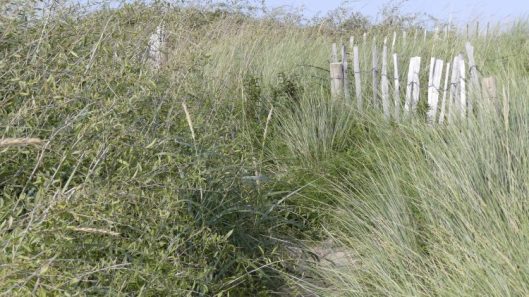 I found a plant that shows off the leaves and flowers quite nicely.
I found a plant that shows off the leaves and flowers quite nicely.
There was a little more Ragwort here that was being visited by a Meadow Brown Butterfly.
At this point you can either take a path that leads back down through the dunes to the beach or carry on along the open path around the golf course. I took the latter, hoping to find a few more wildflowers to add to my list.
Apart from a bit of Traveller’s Joy amongst Marram and brambles, there wasn’t much to see that was still in flower, but I did find a small amount of Lady’s Bedstraw, a single Bloody Cranesbill flower, and a few Harebells to finish off with.
On Sunday, as I already mentioned we took a slightly different route to avoid the wind, but we did see most of the wildflowers that I’ve photographed or named above, which totals to some 40 or more species, and added a couple more. We also found lots of ripe Dewberries and a Cinnabar moth caterpillar on some Ragwort, saw a few bumblebees, but didn’t see a single butterfly.
One wildflower that I should have recognised on the day but that was growing in an unexpected place so had become long and straggly (my excuse!) was Pellitory-of-the-Wall.
And there was a lot more of the blue-flowered ‘mystery’ plant from Thursday’s walk, which turns out to be a rather rare plant in the UK known as Blue Lettuce, or Russian Blue Sowthistle – Lactuca tatarica. I didn’t have time to take good photographs as the group were moving on, but fortunately the one below was good enough for a friend who had seen the plant here herself and researched it, to give me a clue! She later kindly forwarded me the following info from the UKwildflowers website, which is a direct quote:
Known at this site from at least 1963, this introduced plant is also known as Russian Blue Sowthistle. It grows very close to the shore in dunes not far from a car park and is well established now on nearby cliffs. Flowering in late summer it provides an unusual display of many blue/purple flower heads.
L. tatarica is known from very few separate sites throughout England, the Isle of man and the Scillies. This appears to be its only site in Wales, there is none to be found in Scotland and only one site in western Ireland.

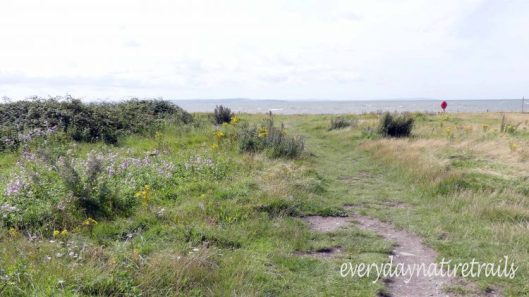




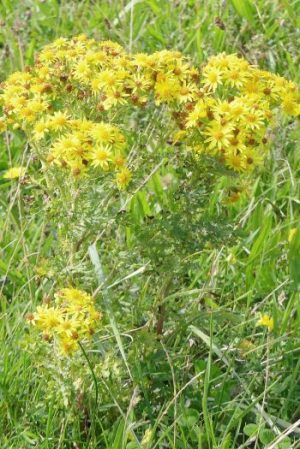
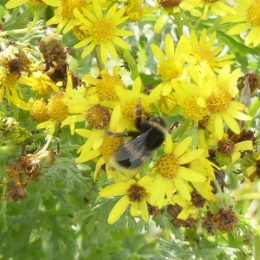




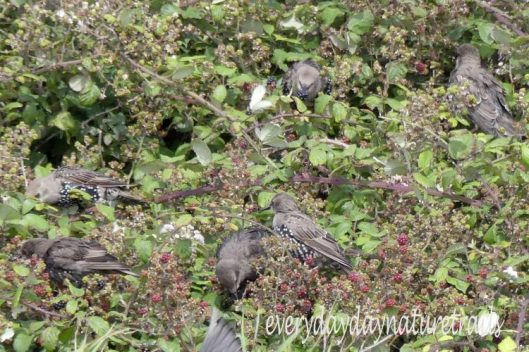

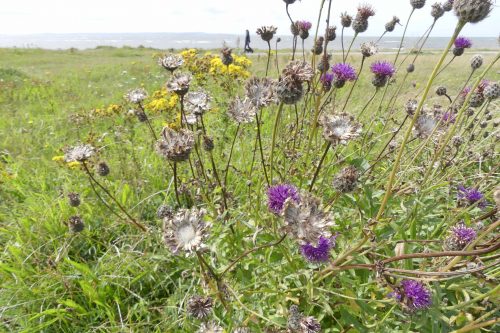
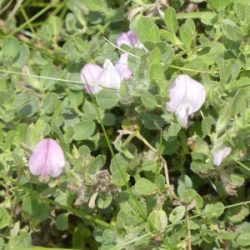

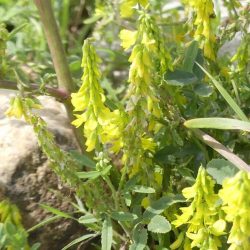
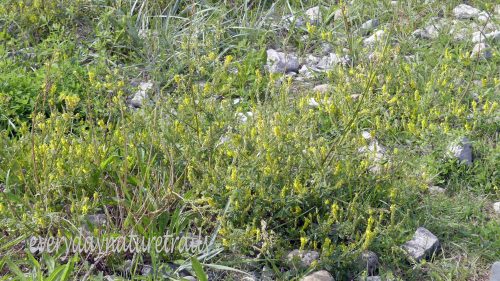





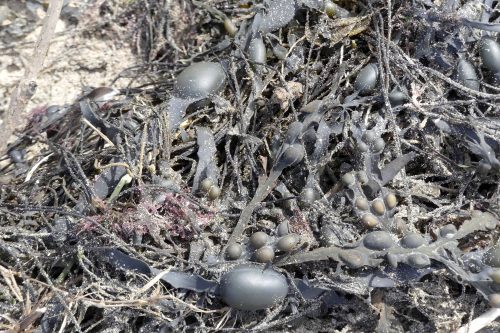
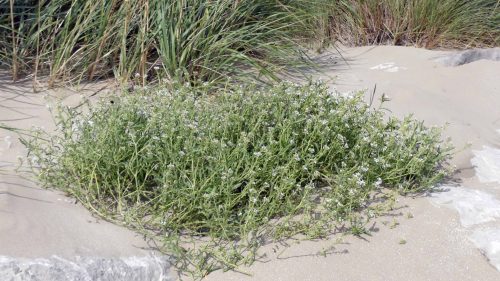




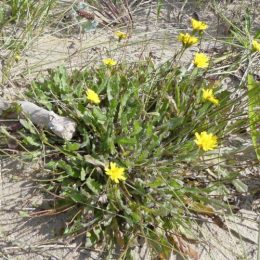








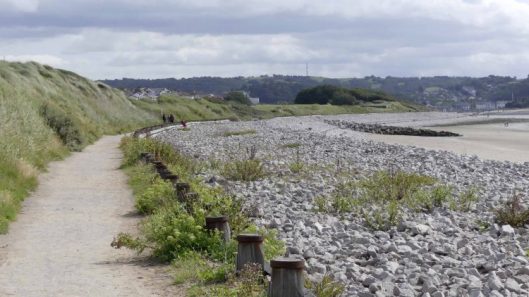


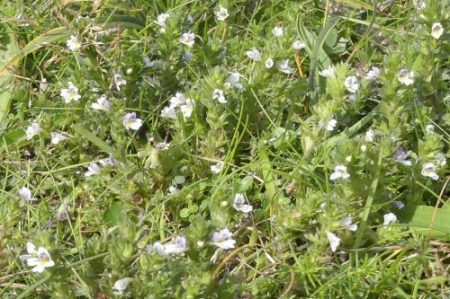

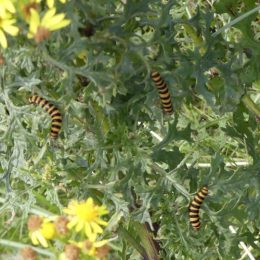



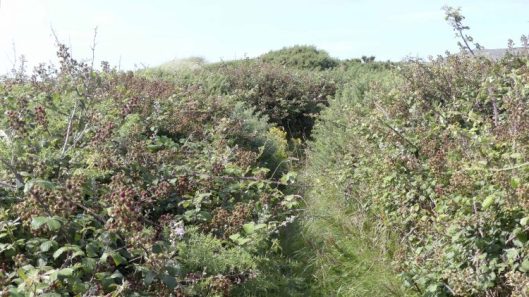












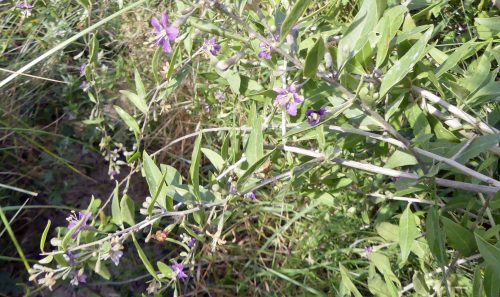







What a lovely post Theresa. I particularly enjoyed seeing the dune vegetation and flowers. I will be revisiting this post as it is such a trove of interesting wild plants.
LikeLiked by 1 person
Thank you, I’m happy to hear you enjoyed the post and doubly so that you found it useful! This is a great spot for a real mix of habitats and so wildflowers in a compact and well-used area that still often brings up little surprises.
LikeLiked by 1 person
Hello,
I just wanted to thank you for your lovely posts. I have a life-time wild flower list that I’ve been doing since 2016. Today, I popped to West Shore to look for ribbed Melilot and sea buckthorn having read your post. Thanks to you I found both and can now add them to my list.
Keep posting! Many thanks, Rosie
>
LikeLiked by 1 person
Thank you for your lovely comments Rosie and I’m happy to have helped grow your wildflower list. I’m still discovering new places and adding to mine, it’s surprising where things pop up!
LikeLike
What a wonderful post Theresa. There’s so much information and it’s such a delight to read all the names and learn the identities of the wildflowers let alone the views of the location and coastal paths. Enjoyed this virtual ramble, thanks for putting it on the map for me.
LikeLiked by 1 person
Thank you so much for your kind comments. This location is wonderful in a myriad of ways and one that is coming under increasing pressure as it’s part of the Wales Coast Path, and also well-used by local folk and holidaymakers too. Fingers crossed the wildlife that’s tough enough to survive the exposure to the elements can handle we humans too!
LikeLiked by 1 person
Thanks again Suzanne – I was going down the lines of Sea Aster for the blue plant at first – way off in terms of habitat! Fortunately Jill was there on Sunday and I showed my pic to her – she put me on the right track & did the research for me, so very grateful to her. Best wishes, Theresa
LikeLike
Hi Theresa and what a wonderful blog post. A fantastic display of flowers along this walk, and so illuminating to have you as a virtual companion and guide, thank you.
LikeLiked by 1 person
Thank you Ruth, you’re very kind. This is a wonderful stretch of our coastline for wildflowers & just generally wandering around – I can’t imagine how long it would take me to accomplish what you have done and are doing, I’d be stopping every metre or so to photograph something & never get anywhere! Best wishes and happy walking, Theresa
LikeLike
Lucky you being so near one of the few blue lettuce sites!
LikeLiked by 1 person
Yes indeed, and even luckier to have seen it – if it hadn’t been such a windy day and taken this path we may well have missed it! Not great weather for our wild bees at the moment, hope yours are fairing well.
LikeLike
So good to see your blog again Theresa. Sorry I didn’t make it to this event. Thank you for sharing about some of the treasures you found on your guided walk. I have done this walk many times over the years and it’s always full of surprises. I was wondering if some of the tall mallows that you saw could have been Tree mallows as I know they grow along this route in some places?
LikeLiked by 1 person
Hi Suzanne, it’s lovely to hear from you. I can’t believe how quickly the summer has flown by and how long it is since I had time to sit and record an outing. Thanks for your thoughts on the Mallow – these were definitely just the common ones, I think they’ve found a particularly fertile spot here and have outdone themselves this year, along with the nettles. I love this walk too and would have appreciated your company to help out with some of the identifications! It was quite hard going in parts with that wind though!
LikeLike
Hi Theresa, yes,come to think of it, the Tree mallows are further along the path than you went so the Common mallows you saw were pretty impressive. You did a great job with IDing the plants you saw. The blue flowered plant had me fooled, I thought it might have been Chicory or Blue sow- thistle, but to hear that is was Blue lettuce is really exciting. What a great find. Best wishes, Suzanne
LikeLiked by 1 person